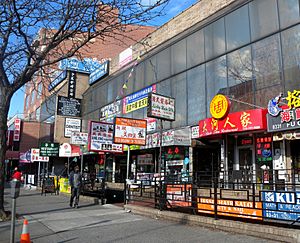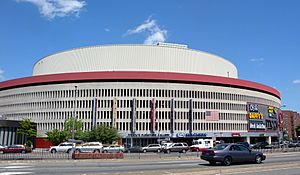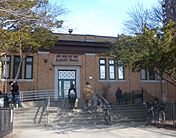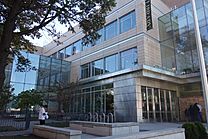Elmhurst, Queens facts for kids
Quick facts for kids
Elmhurst
|
|
|---|---|
|
Neighborhood of Queens
|
|
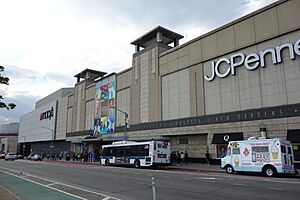
Queens Center Mall in Elmhurst
|
|
| Country | |
| State | |
| City | New York City |
| Borough | Queens |
| Community District | Queens 4 |
| Settlement (Dutch) | 1652 |
| Area | |
| • Total | 3.036 km2 (1.172 sq mi) |
| Population
(2010)
|
|
| • Total | 88,427 |
| • Density | 29,126/km2 (75,436/sq mi) |
| Race/Ethnicity | |
| • Hispanic | 46.1% |
| • Asian | 43.8% |
| • White | 6.6% |
| • Black | 1.3% |
| • Other/Multiracial | 2.2% |
| Time zone | UTC−5 (EST) |
| • Summer (DST) | UTC−4 (EDT) |
| ZIP Code |
11373
|
| Area codes | 718, 347, 929, and 917 |
Elmhurst, once called Newtown, is a lively neighborhood in Queens, one of New York City's five main areas. It is bordered by Roosevelt Avenue to the north and the Long Island Expressway to the south. To the east is Junction Boulevard, and to the west is the New York Connecting Railroad.
This area was first settled in 1652 by English Puritans who named it Middleburgh. It was about 7 miles from New Amsterdam, which is now Manhattan. When the British took over in 1664, they renamed it New Town, which later became Newtown. For a long time, it was a quiet, rural community. In the late 1890s, it was renamed Elmhurst and became part of the larger New York City. In the 20th century, Elmhurst grew quickly with many homes and businesses. Many immigrants from all over the world began moving here in the late 1900s.
Elmhurst is part of Queens Community Board 4 and has the ZIP Code 11373. The New York City Police Department's 110th Precinct keeps the neighborhood safe.
Contents
History of Elmhurst: From Old Towns to Modern City
Early Days: 17th and 18th Centuries
Elmhurst began as a village called Middelburgh in 1652. It was founded by English Puritans from Connecticut and Massachusetts. They were looking for a place to practice their religion freely. The village was located in the Dutch colony of New Netherland.
Middelburgh was about 7 miles from New Amsterdam, which is now New York City. It was also near Maspat (now Maspeth), a settlement that had been left empty after attacks from the local Lenape Native Americans.
When the British took control of New Netherland in 1664, they renamed Middelburgh to Nieuwe Stad, which means New Town in Dutch. This name kept a connection to its Dutch past. Over time, it was simply called Newtown. In 1666, the settlers officially bought the land for Newtown from the Native American tribes.
A town building was built near what is now Broadway and Corona Avenue. It served as a place for both community gatherings and religious services. Different religious groups, like the Church of England and the Quakers, shared this building. In 1669, a new church was planned on land given by Ralph Hunt.
Newtown became the main town for the area in 1683. It had a town hall, a jail, and offices for taxes and records. It was the center of a larger area that included villages north of Forest Park and west of Flushing Meadows.
By 1700, about 1,000 people lived in Newtown. This included many young people, adults, and enslaved people. One famous resident was Gershom Moore, who lived in the Elmhurst part of Newtown. An apple tree on his farm grew a special apple called the Newtown Pippin. This apple became very famous in Colonial America.
The St. James Church was founded in 1704, and the Reformed Church of Newtown followed in 1731. The Colonel Bernardus Bloom Farmhouse, built in the 1600s, was one of the oldest farmhouses in Newtown until 2015.
19th Century Changes
In the early 1800s, Newtown was home to many free Black people and enslaved people. After the American Revolution, more enslaved people gained their freedom. In 1828, a year after slavery in New York state was finally abolished, a landowner named James Hunter gave 2 acres of land for a church and cemetery. This land had been used as a burial ground since 1818 by the United African Society of Newtown, which later became St. Mark's A.M.E. Church.
By 1886, over 300 burials had taken place in the cemetery. The church later moved, and the burial ground was forgotten. In 2011, during a construction project, the remains of a woman were found in an iron coffin. The church is now working to buy the land to protect this historic site.
More homes began to appear in the area after a horse-drawn streetcar line, the Grand Street Line, reached Newtown in 1854. The Long Island Rail Road's Main Line also came through Newtown in 1876, bringing even more people to live there.
Becoming Elmhurst and Joining New York City
In 1896, Cord Meyer bought land in Newtown. He suggested renaming the town "Elmhurst," which means "a grove of elms." In 1897, just before Queens County became part of the City of Greater New York, the town was officially renamed. This change helped separate the town from the nearby, less pleasant Newtown Creek. It also celebrated the many elm trees that grew in the area.
Elmhurst became a popular place to live thanks to new housing built by the Cord Meyer Development Company between 1896 and 1910. The company continued to build more areas like Elmhurst Square and Elmhurst Heights until 1930.
The Long Island Rail Road (LIRR) also had stations in Elmhurst, like the Grand Street LIRR station. In the 1930s, the New York City Subway's Queens Boulevard line was built through the neighborhood. This brought more growth but also led to the demolition of some old buildings.
Before World War II, Elmhurst was mostly a Jewish American and Italian American neighborhood. After the war, it became one of the most diverse neighborhoods in New York City. People from many different countries moved in. By the 1980s, residents from 112 nations lived in Elmhurst, and it has continued to become even more diverse. Many Latino and Chinese American families have made Elmhurst their home.
For many years, the Elmhurst gas tanks were famous landmarks. These huge natural gas storage tanks, built in 1910 and 1921, stood 200 feet tall. Because the Long Island Expressway often had traffic jams near them, "backup at the Elmhurst Gas Tanks" was a common phrase on radio traffic reports. The gas tanks were removed in 2001. The area was then turned into Elmhurst Park, which opened in 2011.
Elmhurst's Diverse Community
Elmhurst is known for its amazing diversity. Based on the 2010 United States Census, Elmhurst had 88,427 people. The neighborhood is very mixed, with a large percentage of Hispanic or Latino residents (46.1%) and Asian residents (43.8%). There are also smaller groups of White and Black residents.
The Latino population in Elmhurst comes from many different countries, including Ecuador, Colombia, Mexico, and the Dominican Republic. The Asian population also includes people from various backgrounds, such as Chinese, Filipino, and Korean.
Most people in Elmhurst and Corona are middle-aged adults and young people. The average life expectancy in this area is 85.4 years, which is higher than the average for New York City.
Elmhurst's Chinatown
Elmhurst has a fast-growing Chinatown (艾浒 唐人街), which is the second largest in Queens after the one in Flushing. This area, once a small collection of Chinese shops on Broadway, has grown to include 45th Avenue and Whitney Avenue. It's like a smaller version of the Flushing Chinatown.
You'll find many businesses from Southeast Asia here, including Malaysian, Singaporean, Indonesian, Thai, and Vietnamese shops. Large Chinese supermarkets like Hong Kong Supermarket and New York Supermarket offer a wide variety of foods. Cathay Bank is the main Chinese bank in the area, though other banks like HSBC and Chase are also on Broadway. Like Flushing, many people here speak Mandarin Chinese, along with other Chinese languages.
Since the 2000s, Elmhurst's Chinatown has even spread into the nearby neighborhood of Corona, Queens.
Important Places in Elmhurst
Official Landmarks and Historic Buildings
Elmhurst has several buildings that are considered important historical sites. Some are listed on the National Register of Historic Places (NRHP) or are New York City Landmarks (NYCL):
- Benevolent and Protective Order of Elks, Lodge Number 878 (NRHP, NYCL): Built in 1923–1924, this was once the largest Elks lodge in the Eastern United States.
- First Presbyterian Church of Newtown (NRHP): This church was built in 1895.
- Newtown High School (NYCL): This beautiful building, in a style called Flemish Renaissance Revival, was built in 1921 and made bigger in 1931.
- Reformed Church of Newtown (NRHP, NYCL): This is one of the oldest wooden churches in New York City. It was first started by Dutch immigrants in 1731.
- St. James Church (NRHP, NYCL): Built in 1735, this is the oldest surviving Anglican church building in the city.
Places of Worship
Elmhurst is home to many different places of worship, showing its diverse community:
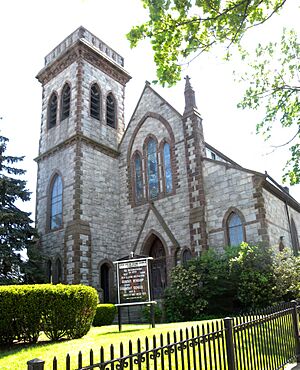
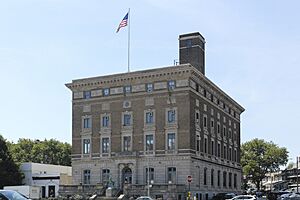
- Ascension Roman Catholic Church
- Bangladesh Hindu Mandir
- Christian Testimony Church: This building was once a synagogue and is now a Christian church with a Chinese congregation.
- Elmhurst Baptist Church: Founded in 1900, this stone church has a very diverse congregation.
- Elmhurst Islamic Center (EIC)
- Elmhurst Muslim Center
- First Presbyterian Church of Newtown: The congregation started in 1652, and the current building was built in 1895.
- Geeta Temple Asharam
- Jain Center of America: Founded in 1973.
- New Life Fellowship Church: This church is located in the historic Benevolent and Protective Order of Elks, Lodge Number 878 building.
- Reformed Church of Newtown: Founded in 1731, the church has a small, historic graveyard.
- The Rock Church at Elmwood Theatre: This church is housed in the former Loews Elmwood Theater, which was built in 1928 and could seat 3,000 people.
- Satya Narayan Mandir
- St. Adalbert Roman Catholic Church: Founded in 1892.
- St. Bartholomew's Church: Founded in 1906.
- St. James Church: This is Elmhurst's oldest building, built in 1734. It was originally an Episcopal church and is now on the National Register of Historic Places.
Shopping Malls
Elmhurst has two large shopping malls:
- Queens Center: This huge mall has 150 stores and opened in 1973. It was renovated and expanded in 2002–2004. It's built on land that used to be a children's amusement park called Fairyland.
- Queens Place Mall: This smaller mall, shaped like a cylinder, opened in 1965. It was designed in a unique way because one homeowner refused to sell her house, which was in the way of the original rectangular plan.
Streets and Parks in Elmhurst
Interesting Street Names
- 57th Avenue was once known as the Flushing and Newtown Turnpike, built in 1801.
- Elks Road is a short street named after the Elks Lodge.
- Hoffman Drive is a small part of the old Hoffman Boulevard, which was straightened and renamed Queens Boulevard.
- Horace Harding Expressway was once Nassau Boulevard. It was renamed after Horace J. Harding, a finance leader who supported city parkways. It's now the service road for the Long Island Expressway.
- Horse Brook Island is a traffic island named after a creek that used to flow through the area.
- Justice Avenue has an unusual curved path because of an old railroad line that used to be there.
- Queens Boulevard is a very wide highway that was once two small dirt roads. It's sometimes called the "Boulevard of Death" because of its high accident rate.
- Whitney Avenue has many religious buildings and follows a unique tilted street grid.
- Woodhaven Boulevard was known as Trotting Course Lane because horses were the main way to travel back then.
Parks and Green Spaces
Elmhurst has several parks where you can relax and play:
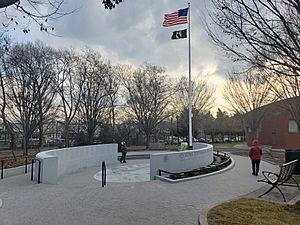
- Elmhurst Park: Located on 57th Avenue, this park has a playground, swings, exercise machines, and walking paths. It opened in 2011 on land that used to have gas tanks. It also includes the Queens Vietnam Veterans Memorial.
- Moore Homestead Park: This park is named after a home owned by Clement Clarke Moore, who wrote the famous poem "A Visit from St. Nicholas" (also known as "'Twas the Night Before Christmas"). The park has a playground, basketball courts, and handball courts.
- Frank D. O'Connor Playground: This park, named after a former state senator, has a playground, basketball, and handball areas. It opened in 1937.
- Veterans Grove: This small park on 43rd Avenue is dedicated to soldiers from Elmhurst who died in World War I.
- Horsebrook Island: A small green space named after a stream that used to run through the area.
- Libra Triangle: Another small green space at the meeting point of Justice Avenue and Broadway.
- Newtown Playground: Located near Queens Center Mall and Newtown High School, this park has two playgrounds, chess tables, swings, and sprinklers. It's named after Elmhurst's original name.
Education and Libraries in Elmhurst
Schools in Elmhurst
Elmhurst has many schools for students of all ages:
- PS 7 - Louis F. Simeone
- PS 13 - Clement C Moore
- PS 89 - Elmhurst
- PS 102 - Bayview
- PS 877 - 51st Avenue Academy (now called PS 7 Academy)
- St. Adalbert School
- St. Bartholomew School
- IS 5 - The Walter Crowley Intermediate School
- Newtown High School: This school is in a beautiful building designed in 1897.
- Cathedral Preparatory School and Seminary: This is a unique Roman Catholic high school seminary.
- The Elmhurst Educational Complex: Opened in 2008, this complex is a renovated spice factory that now holds three high schools, an elementary school, and an early childhood center.
- Central Queens Academy Charter School
Students in Elmhurst and Corona generally do well in school. The percentage of elementary school students who miss a lot of school days is lower than the rest of New York City. Also, a high percentage of high school students in Elmhurst and Corona graduate on time.
Elmhurst Library Branch
The Queens Public Library's Elmhurst branch is located at 86-01 Broadway. The original library, built in 1906, was a Carnegie library. It was torn down in 2012 to build a much larger, modern library. The new four-story building, which is 32,000 square feet, opened in December 2016. It cost $32 million to build and includes parts of the original design.
Getting Around Elmhurst: Transportation
Elmhurst has many ways to get around New York City:
Subway Stations
The New York City Subway has several stations in Elmhurst:
- Jackson Heights–Roosevelt Avenue
- Woodhaven Boulevard
- Grand Avenue–Newtown
- Elmhurst Avenue
These stations are all served by the E M R trains trains on the IND Queens Boulevard Line.
The IRT Flushing Line, served by the 7 <7> trains train, runs along Roosevelt Avenue, which is the northern border of Elmhurst. Its stations include:
- 74th Street–Broadway
- 82nd Street–Jackson Heights
- 90th Street–Elmhurst Avenue
Bus Routes
Many local buses serve Elmhurst, including the Q11, Q21, Q29, Q38, Q47, Q52 SBS, Q53 SBS, Q58, Q59, Q60, Q72, Q88. Express buses, like the QM10, QM11, QM12, QM40, QM42, travel to and from Manhattan during busy weekday hours.
Major Roads
Elmhurst is bordered by the Long Island Expressway to the south and the Brooklyn-Queens Expressway to the west. Important roads in the community include Queens Boulevard, Woodhaven Boulevard, Junction Boulevard, Roosevelt Avenue, and Broadway. Queens Boulevard connects Elmhurst to Manhattan and Jamaica. Woodhaven Boulevard connects to John F. Kennedy International Airport, and Junction Boulevard connects to LaGuardia Airport.
Famous People from Elmhurst
- Tommie Agee (1942–2001), baseball player
- Mose Allison (1927–2016), jazz player
- Eric B (born 1965), DJ from the hip-hop duo Eric B. & Rakim
- Harry Belafonte (1927–2023), famous singer and Grammy winner
- Julissa Bermudez (born 1983), actress and TV host
- Brian Brady (born 1962), former baseball player
- William J. Casey (1913–1987), former director of the CIA, born in Elmhurst
- Patty Duke (1946–2016), actress and former president of the Screen Actor's Guild, won an Academy Award for The Miracle Worker
- Joan Hackett (1934–1983), actress
- Homeboy Sandman (born 1980), rapper
- Bill Kenville (1930–2018), former NBA basketball player
- Fumio Kishida (born 1957), former Prime Minister of Japan, attended elementary school in Elmhurst
- Omar Minaya (born 1958), former General Manager of the New York Mets, grew up in Elmhurst
- Benjamin Moore (1748–1816), bishop of New York
- Clement Clarke Moore (1779–1863), author of the poem "A Visit from St. Nicholas"
- John Moore, one of Elmhurst's founders
- Tony Pastor (1832–1908), vaudeville entertainer
- Carroll O'Connor (1924–2001), actor, famous for his role as Archie Bunker on All in the Family
- Frank D. O'Connor (1909–1992), attorney and judge
- Smush Parker (born 1981), former NBA basketball player
- Lindy Remigino (1931–2018), Olympic gold medalist sprinter
- Tommy Rettig (1941–1996), actor who played Jeff on the Lassie TV series
- Dixie Roberts, vaudeville dancer
- Antonin Scalia (1936–2016), former Associate Justice of the Supreme Court of the United States, attended elementary school in Elmhurst
- Risë Stevens (1913–2013), opera singer
- Charlie Villanueva (born 1984), former NBA basketball player
Images for kids


